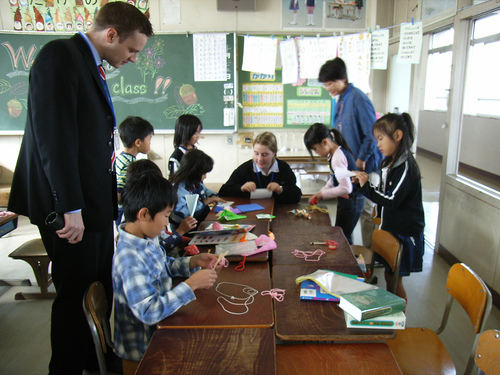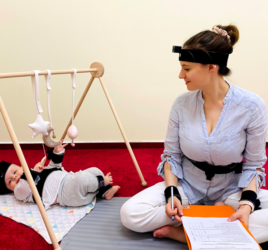
Professional development for teachers in a complex world
Teachers play a central role in children’s mastering of 21st century skills (Binkley et al., 2012). In order to keep pace with a rapidly changing world, teachers’ professional development needs to continue after their formal education. It is therefore of utmost importance to design interventions for professional development, and to know how they can be successfully implemented. According to the literature, interventions should take specific aspects into account with regard to (a) the intervention itself (for instance form or duration), (b) the teacher (for instance the teacher’s autonomy), (c) the context (for instance the school board), and (d) implementation (for instance intervention training) (Garet, Porter, Desimone, Birman, & Yoon, 2001).
Approaches to interventions for Professional Development
Models that describe the effectiveness and sustainability of teacher professional development interventions from a “classical” viewpoint assume that the addition of relevant aspects, such as the form, duration and autonomy support of the teacher can explain the effectiveness of the intervention (Garet et al, 2001). However, this assumption does not take the individual and temporal aspects of the intervention process into account.
“the actual effectiveness of an intervention in a concrete context develops out of a process taking place in time”
In my dissertation research, I took the position that the actual effectiveness of an intervention in a concrete context cannot just be modeled based on the sum of relevant variables (cf. Molenaar & Campbell, 2009). First of all, the actual effectiveness of an intervention in a concrete context develops out of a process taking place in time. Second, it is a process taking place in a particular context, with specific individuals and people who carry out the treatment. Third, it is a process taking place in a complex system, namely, a system of intertwining teacher, child, school, cultural and community variables. Therefore, looking at interventions for professional development as a simple cause-and-effect process does not do justice to the complexity of functioning as a teacher in a specific school context, and to the complex world in which teachers function (Goldspink, 2007).
For instance, according to the classical approach the context in terms of the kind of school is considered as an independent and distal variable, as in forming (just) a statistical association with the academic performance of children (Van Geert & Steenbeek, 2005). In my dissertation, I propose that the context should be considered as a proximal, dynamic factor, meaning that the context is continuously created by the actions of the participants (teachers, pupils, etc.), and that the actions of the participants are continuously determined by the created contexts (Steenbeek & Van Geert, 2007). This complexity approach proceeds from the idea that an intervention or activity, aimed at improving the teacher’s behavior, can be regarded as an important component that changes the context in which the teacher functions. Given the mutuality of person and context, the exact way in which a particular intervention unfolds is not independent of the reactions of the teacher to the intervention, or of the teachers’ input in the intervention. That is to say, even if we guard the controlled implementation of a particular intervention, its concrete form over time will unavoidably be influenced by the teacher(s) and by the effect the intervention has on the teacher(s) and other significant parts of the school context. At the same time, the intervention changes the teacher as a learning individual as well.
As an illustration, in my dissertation research we provided video-feedback coaching to teachers in order to improve their abilities to stimulate scientific reasoning skills of children in the classroom, by asking more scientific reasoning eliciting questions (e.g., what do you think will happen if I throw a pencil in water, and why do you think it will sink to the bottom?). On the group level, the teachers increased significantly in their use of scientific reasoning eliciting questions, and their pupils showed an increase in their level of reasoning, with intermediate to large effect sizes (Wetzels, 2015). However, these results were not visible for all teachers, which can be explained from a complexity viewpoint. In the case of teacher Laura, for instance, she was enthusiastic about the intervention because its goals fit with the school’s approach, the principal was enthusiastic, as were her co-workers. Her personal concerns, school specific aspects and intervention specific aspects worked intertwiningly together in a positive spiral to produce a relatively positive result. On the other hand, in the case of teacher Anne, the intertwining of aspects unraveled very differently, that is, she was not enthusiastic at the start, nor was her principal, from which a negative feedback loop developed that ultimately led to a relatively negative result.
Thus, the effect of interventions on teachers in a specific school context is shaped by various intervention-, teacher-, context-, and implementation aspects, which combine in such ways that a particular intervention can have multiple outcomes, dependent on the dynamics of the context-teacher relationship. This implies that, as the results of my PhD demonstrate, it is highly likely that average results of a particular sample or population of individuals are not true for each member of the sample or population (Rose, Rouhani, & Fischer, 2013). Hence, in order to understand how and to what extent interventions work, they should be studied in the context of actual intervention processes taking place in individual teachers (Molenaar & Campbell, 2009).
Conducting Interventions in the Future
To conclude, when conducting an intervention study, researchers should take into account that the separate aspects are important, but also that all these aspects are intertwined in a real world situation. On the one hand, the classical sample-based average effect of the intervention can inform us about the net effect of an intervention for a particular group or population, and is typically important at the level of policy-making. On the other hand, the case-based dynamic understanding of how the actual intervention process leads to a particular result for a particular person (or for a particular school or team of teachers) is typically important at the level of actual intervening. This latter “complexity” approach provides information about how actual interventions unfold at the level of individual teachers, and how they can be adapted. Thus, to successfully develop, assess and conduct an intervention for professional development in the future, “classical” and “complexity” approaches should always be combined.
References
Binkley, M., Erstad, O., Herman, J., Raizen, S., Ripley, M., Miller-Ricci, M., & Rumble, M. (2012). Defining twenty-first century skills. In P. Griffin, B. Care, & E. McGaw (Eds.), Assessment and teaching of 21st century skills (pp. 17-66). New York: Springer.
Garet, M.S., Porter, A.C., Desimone, L., Birman, B.F., & Yoon, K.S. (2001). What makes professional development effective? Results from a national sample of teachers. American Educational Research Journaleducational Research Journal, 38, 915. doi: 10.3102/000283120380
Goldspink, C. (2007). Transforming education: Evidential support for a complex systems approach. E:CO, 9, 77-92.
Molenaar, P.C.M., & Campbell, C.G. (2009). The new person-specific paradigm in psychology. Current Directions in Psychological Science, 18, 112-117. doi: 10.1111/j.1467-8721.2009.01619.x
Rose, L.T., Rouhani, P., & Fischer, K.W. (2013). The science of the individual. Mind, Brain, and Education, 7, 152-158. doi: 10.1111/mbe.12021
Steenbeek, H.W., & Van Geert, P.L.C. (2007). A theory and dynamic model of dyadic interaction: concerns, appraisals, and contagiousness in a developmental context. Developmental Review, 27, 1-40. doi: 10.1016/j.dr.2006.06
Van Geert, P.L.C., & Steenbeek, H.W. (2005). The dynamics of scaffolding. New Ideas in Psychology, 23, 115-128. doi: 10.1016/j.newideapsych.2006.05.003
Wetzels, A.F.M. (2015). Curious minds in the classroom: The influence of video feedback coaching for teachers in science and technology lessons (Unpublished doctoral dissertation). University of Groningen, Groningen.



